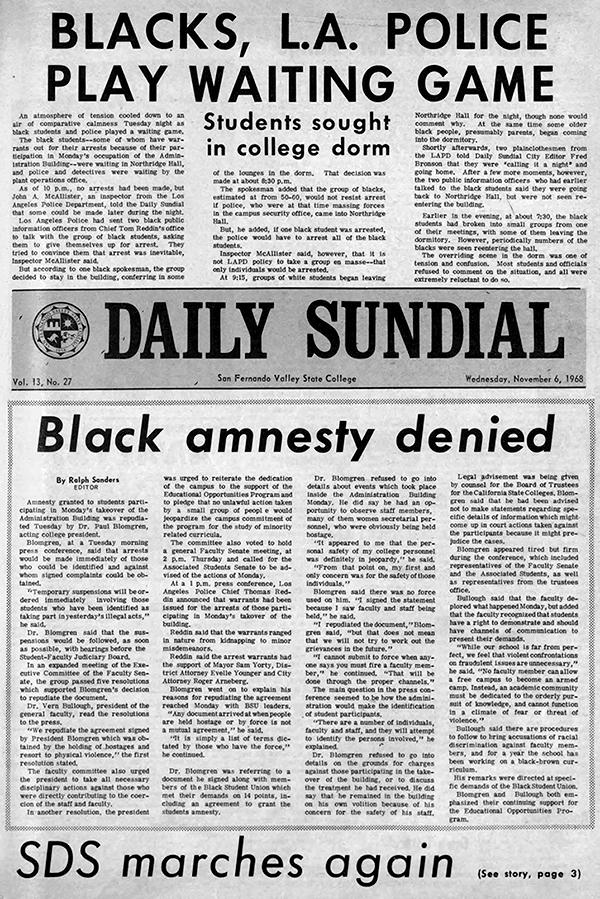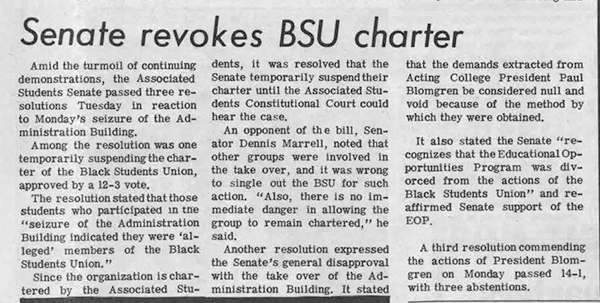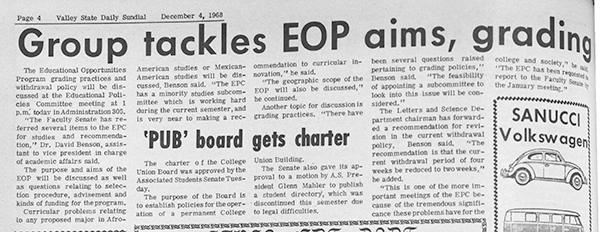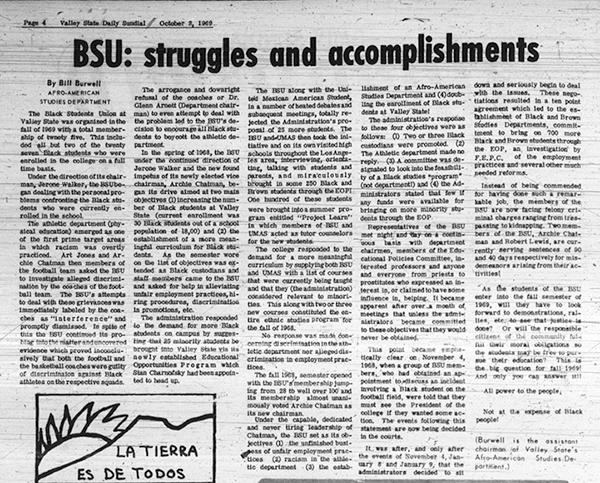A documentary timeline of events leading to the first ethnic studies degrees on campus.
Charges of athletic discrimination and a letter from Archie Chatman
The Black Student Union (BSU) accuses the Valley State Athletic Department with racial discrimination within the football program and outlined four areas with which to provide equitable treatment of their black players. Meanwhile, in a letter to the editor of the Sundial, Archie Chatman of the BSU decries discrimination on campus, calling for an end to racial inequities. See page 4.
Mexican American tolerance exhausted
In an open forum at Valley State, Central and California representatives of United Mexican American Students (UMAS) list grievances regarding years of treatment of the Mexican American community and outline proposals intended to eradicate oppression on campus. These include the removal of racial stereotypes, and racially representative teachers. These grievances are a credited for motivating recent local high school walkouts. Also showing support of UMAS at the forum is BSU and Students for a Democratic Society (SDS), a multi-issue activist group. See page 3.
Black Student Union president speaks out for liberation
"The liberation of black people, which is necessary by any means, is the generalized philosophy of all Afro-American movements," says Jerome Walker, President of the Valley State College Black Student Union. Addressing the inequity on campus regarding an ethnically representative student body and curricula, Walker discusses high school recruitment efforts to boost minority enrollment from the local community.
Minority consultant claims minority issues are already under consideration
Under the leadership of Professor Charnofsky, minority issues begin to be addressed by working with the Black Student Union (BSU), United Mexican-American Students (UMAS) and other stakeholder groups on campus. Among the developments is a two percent increase in special admissions that lowers the eligibility requirement for minority students and provides them with faculty sponsors. Meanwhile, Educational Opportunity Program Chairman, Dr. Malcolm Sillars recommends 16 Ethnic Studies course additions. See page 4.
Black enrollment is up, but still low
Community student recruitment by BSU results in the enrollment of 150 of the 170 new African American students in the fall of 1968. In addition, pressure by BSU and UMAS helps create six additional courses on minority subject matter. Despite this success, the roughly 200 black students make up about 1 percent of the student body.
BSU wants Freshman football coach fired
BSU schedules a meeting with the Athletic Director to demand the firing of the Freshman football coach accused of racist behavior resulting in a physical attack on a black player following a defeat to Cal Poly San Luis Obispo. Meanwhile, Students for a Democratic Society (SDS) plans an election day class walkout for Monday, November 4th. See page 3.
BSU, SDS occupy three floors of the Administration Building
On November 4th, members of the Black Student Union (BSU) and Students for a Democratic Society (SDS) occupied three floors of the Administration Building for four hours to demand discussion of issues involving mistreatment of Black athletes and present a list of twelve demands. Crowds in front of the building swell to 1,200, and approximately 250 LAPD officers gather on campus.
SFVSC Black Student Union's November 4th Demands
Among the list of demands BSU delivered to the Acting President Blomgren included that he "strongly recommend an Afro-American Studies Department and curriculum" to be headed and taught by black individuals, as well as a demand to substantially increase black student enrollment on campus. Further, the list demands that no charges be filed nor disciplinary action regarding the group's activities on this day.
Campus Demonstrations
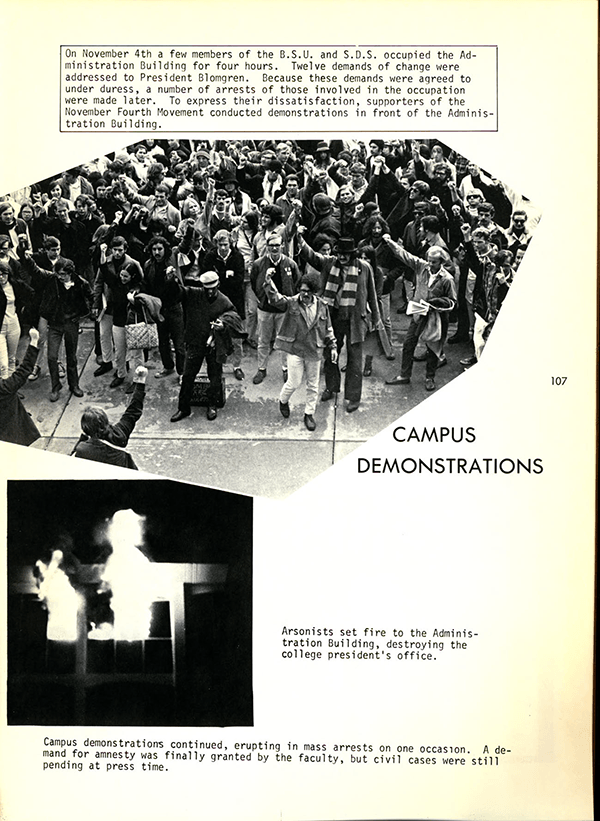
Photographs of the November 4th student march and related arson of the of the Administration Building on December 8, 1968 published in the 1969 Matador yearbook. Yearbook description of photographs: " On November 4th a few members of the B.S.U. and the S.D.S. occupied the Administration Building for four hours. Twelve demands of change were addressed to President Blomgren. Because these demands were agreed to under duress, a number of arrests of those involved in the occupation were made later. To express their dissatisfaction, supporters of the November Fourth Movement conducted demonstrations in front o the Administration Building. Campus demonstrations continued, erupting in mass arrests on one occasion. A demand for amnesty was finally granted by the faculty, but civil cases were still pending at press time."
Inset caption: "Arsonists set fire to the Administration Building, destroying the college president's office."
Black students wait to be arrested by the LAPD
Fifty to sixty Black students, parents and others wait in Northridge Hall in solidarity with those facing arrest for the occupation of the Administration Building. LAPD amasses forces on campus.
Three hundred rally to meet with Blomgren
An estimated crowd of 300 rallies in front of the Administration Building to condemn President Blomgren's lack of response to claims of racial injustice. See page 3.
A.S. revokes BSU's charter
The Associated Students Senate passes a resolution to temporarily suspend the Black Student Union charter in reaction to the Administration Building occupation. See page 3.
Twenty-three BSU members are arraigned; Faculty backs Blomgren but also the EOP
Twenty-three Black Student Union members surrender voluntarily, and are arraigned on charges of conspiracy, kidnapping, burglary, robbery, assault, and false imprisonment. In all there were 43 "wanted," that is, 24 warrants with an additional 19 wanted with one arrest. Ultimately 23 were arraigned as stated above. A page three article lists 33 were arrested, but no follow-up was made. Meanwhile, attendees of a special session of the General Faculty pass a resolution that any agreement signed by President Blomgren during the Administration Building occupation is null and void. The group also reaffirms support for the Educational Opportunities Program (EOP).
Three hundred march in support of BSU and SDS
The "Nov. 4 Committee" calls a press conference, and an estimated crowd of 300 march to protest actions of the administration and police. See page 3.
Charnofsky calls out intimidation in wake of November 4th
Student journalist, Frank Del Olmo (later creator of the United Association of Hispanic Journalists in 1984) interviews Stan Charnofsky, Director of the Educational Opportunity Program (EOP) that helps students with social and economic barriers. Charnofsky, a supporter of the BSU demands, disagreed with their method of protest, but also blamed Administration and police for blatant and sustained intimidation of students not involved in the incident.
United Mexican American Students support BSU
Now ten days after the November 4th incident, UMAS members, Timmi Villegas and Frank Lechuga co-author a brief essay showing full support for BSU. In it they argue that years of their parents' taxes have gone to support higher education, which should reflect curricula that supports the interests of minority students. Specifically they cited the UMAS proposal of a "Chicano Studies" degree program. In addition to strong criticism of the Administration, they condemn the actions of the Student Senate that resulted in the suspension of the BSU charter. See page 2.
EPC discusses new minority departments and EOP
The Educational Policies Committee (EPC) plans to discuss the proposed majors in Afro-American, and Mexican-American Studies and objectives of the Educational Opportunities Program. See page 4.
BSU issues position paper; repeats demands; calls for Afro-American Studies
The Black Student Union issues the position paper "By Any Means Necessary," repeats a list of 12 demands, and notes reforms achieved through activism, including the establishment of the Equal Opportunities Program and proposed curriculum revisions. See page 3.
Rally causes turmoil in front of the Administration Building
An estimated crowd of 1,000 gathers in front of the Administration Building to discuss attempts to meet with Acting President Delmar T. Oviatt. Police charge the crowd and make arrests after a window is broken.
Standoff

Officers positioned inside the Administration building descend into the lobby to prevent student demonstrators from entering the building. However, it was agreed that only student group leaders intended to enter the building to speak to administrators. Upon entering, the student leaders were quickly grabbed by police. Seeing this, a demonstrator threw a cement ashtray through the glass and a brutal police crackdown ensued, injuring and arresting many demonstrators. This photograph was published in the 1979 yearbook as part of the campus 20-year anniversary issue, and depicts the moment police inside the Administration Building guard the entrance from the many protesters on the other side.
Two hundred and seventy-five people are arrested at an assembly
One hundred uniformed police officers sweep through a peaceful rally of faculty and students protesting the student treatment from the day prior. Police however, declare it an illegal assembly. Of the 275 arrested, none resist, yet the campus is declared to be "in a state of emergency." Activist and Professor emeritus, Rodolf Acuña described in his book, The Making of Chicana/o Studies: In the Trenches of Academe the many women and men who were arrested on this day fighting for ethnic studies on campus (Acuña, 2011, 49).
BSU Chairman Archie Chatman is interviewed
Archie Chatman, Chairman of the Black Student Union, discusses events leading up to the Nov. 4 occupation of the Administration Building. See page 2.
Rudy Acuña is named director of Mexican-American Studies
California State Dominguez Hills history professor Dr. Rodolf Acuña is appointed to head the new Mexican-American studies program at SFVC.
The assistant director of Afro-American studies describes the program
William Burwell, Assistant Director of the Afro-American studies program describes his role and plans for the program's development. See page 3.
Twenty-four are found guilty, four are acquitted on charges from arrests on Jan. 9
Twenty-four people are found guilty and four more are acquitted on charges of failing to disperse during the Jan. 8, 1969 campus demonstration (see page 6). Out of 275 initial arrests from the January 8th demonstration, there were ultimately 28 indicted. 4 were acquitted, leaving 21 and of those, 13 were found guilty of their charges.
A 12-point minority plan moves forward
A 12-point agreement outlines the creation of Afro-American and Mexican-American studies programs, investigations into employment practices, the inclusion of community representatives on the College Advisory board, and other issues of concern to minority students. The agreement was reached by a committee composed of BSU and UMAS members as well as faculty.
Curricula is proposed for Afro-American and Mexican-American Studies
The Educational Policies Committee meets to discuss proposals for the creation of Afro-American and Mexican-American studies programs and proposed curricula.
Afro-American and Mexican-American studies departments are approved by the Educational Policies Committee
The Educational Policies Committee (EPC) unanimously approves the creation of Afro-American and Mexican-American studies programs to be offered during the 1969 fall semester.
BSU's struggles and accomplishments are outlined
Bill Burwell, Assistant Chairman of the Afro-American Studies Department presents a history of the Black Student Union, outlining its accomplishments and challenges. See page 4.
Black Faculty member defends Afro-American Studies
Barbara Rhodes makes very pertinent argument for the studies department in response to a Herald-Examiner article written by George Crocker. See page 5.
Directors of ethnic studies programs predict their growth
Dr. Rodolf Acuña, Director of Mexican-American studies and William Burwell, Assistant Chairman of the Afro-American studies program, describe curricula, faculty hires, involvement with community members, and the Educational Opportunity Program. See page 4.
The Sundial reviews the events of Nov. 4, 1968
A Sundial news editor reviews events leading to and following the Nov. 4, 1968 occupation of the Administration Building.











